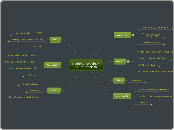Regional Studies/
South America
Argentina
Traditionally goberned by an oligarchy
One of the most
famous presidents:
Juan Domingo Peron
(1946)
Established an
authoritarian and
populist regime
Military took power
(1976 and 1982)
1976
Not successful in economic terms
Lots of "desaparecidos"
Military hunta headed
by: General Videla
Dictatorial, prosecuted
anyone who opposed it
1982
Conflict with
Great Britain:
Falkand Isles
Argentina lose
Reputation of military
government damaged
irreparably
Democratic process
Raul Alfonsin
(1983)
High hopes
Huge
economic
problems
Cristina
Fernandez
de Kirchner
(2011)
First female
president in
Argentina
Wife of former president
Brazil
Militar dictatorship (1964 - 1985)
Caused by political and social inestability
Fernando Collor de Mello (1989)
Won first direct elections
Lula da Silva (2002)
Economy stayed open, regulated while
regulating the flow of capitals
First leftist to arrive presidency
Become South America's largest economy (2008)
Chile
Presidents
Salvador Allende (1970)
Augusto Pinochet (1973)
Dictatorship, that
used, repression
to control the
population.
Introduction to neoliberalism model
Michelle Bachelet (2006)
First female president of
the country
Protests: especially
from students
demanding better
education
Sebastian Piñera (2010)
First conservative
before Pinochet
Two weeks before inauguration
an 8.8 earthquake hit Chile
Venezuela
Was not affected by dictatorship
Has lived uninterrumped democracy since 1958
Presidents
Luis Herrera Campins
Decreased exports, increases inflation and unemployment
Carlos Andres Perez
Decreased exports, increases inflation and unemployment
Hugo Chavez (1998)
Populist regime with high expenses on education and food
Controversial because relation with Cuba and Iran
Nationalization of:
Petroleum
Telecommunications
Electricity
Steel
Subtopic
He can reelect this year
Peru
Juan Velasco Alvarado (1968)
Nationalistic
government
Promoted an
agrarian and
educational
reform
Military took control (1975)
A civil government returned
in 1980 with: Fernando
Belaunde Terry
Shining path: Revolutionary
organization that embraced
Maoism and guerrilla tactics.
Presidents
Alan Garcia (1985)
During his presidency,
the insurgence problem
grows
He is reelected after
Alejandro Toledo, he
still faces low approval
and criticisms
Alejandro Toledo (2001)
First indigenous president of the country
Colombia
Elite of coffee plantation owners
Period "La Violencia" (1946 - 1964)
Confrontation between
Liberals and Conservatives
ELN and FARC were created
At some point, 70% of
the marihuana imported
to the United States
came from Colombia
In the 70's, the importance of Colombia
as a drug supplier grew immensely
Presidents
Edgar Gaviria (1990)
He was from the liberal party.
During his term, the fight
against cartels and to stop
violence were approached
in a more direct way
Alvaro Uribe (2002 - 2010)
Started a strong fight
against cartels and
guerrillas
Juan Manuel de los Santos (2010 - ...)
He was the former defense
minister of Alvaro Uribe
Bolivia
Political inestability
Between 1978-1982,
"ten different governments
were in charge of the country
Presidents
Paz Estenssoro (1985)
Implemented strict
measures against
hyperinflation, because
they had the highest
inflation rate in the world
Paz Zamora (1989)
He continued with the
same policies, he emphasized
the domestic production of
food and raw materials
Sanchez de Lozada (2002)
Strong recession, forced
to ressign one year later
Evo Morales (2005)
Leftist reformist.
First indingenous
descent president
of Bolivia
More taxes for
the wealthier
population
More rights for the indigenous communities
Nationalization of the
oil industry in 2006 and
also railroads and mines
He reformed the constitution and reelected in 2009
Poorest country in SouthAmerica
